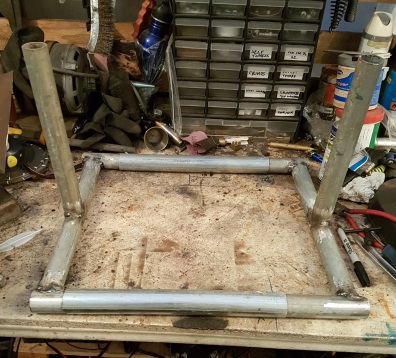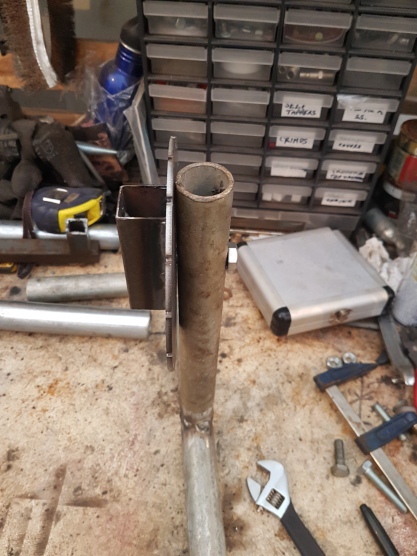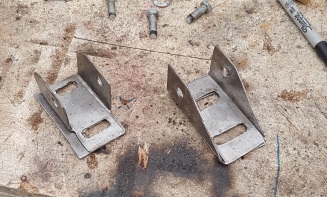
Since time immemorial, I have stripped and built engines on the bench or on the floor…
…and it’s a royal pain in the backside. Trying to balance the thing at suitable angles, hefting it about, running out of hands at every turn and of course, that searing pain when you realize which part of your anatomy it was resting on when you hit it.
But no more, I say! Rupert Ratio has a drawing for a decent one, which you can lay on its side, in the back of his book.
Before embarking on production I had a quick look at fleabay (it’s often cheaper to buy than build) where I saw a truly snazzy one which rotated through about 300 degrees.
On closer inspection, it had a couple of drawbacks. One was a fairly substantial price tag and the other that the rotation was locked by a bolt through a radial slot in a circular plate. This means that only the friction applied by the bolt would be holding it, which just didn’t sound quite enough when you start riving on the thing with a big bar, or even have to tap something off/out.
However, this is the backyard builder and suitably inspired I headed for my various scrap bins to see what I could find…
I have to confess that I bought some bits. Actually two steel discs (offcuts on fleabay, presumably out of the middle of something with a hole in) and two M10 nuts and bolts.
To action!
The steel discs were marked out thus…

For marking out rough stuff I love my little white paint pen. It’s nowhere near as accurate as engineers blue and a scriber, but a lot less messy.
Then bolted together, stuck in a vice and attacked with an angle grinder.

A chunk of square section provided the next bits. Chopped up and drilled as below…
A quick zap with the welder renders all the nuts captive… then the channels get glued to the discs


Now I need something to hold them off the ground…
I cadged half a dozen four meter lengths of this heavy walled tube from some chaps who were chucking it in a skip. It used to be handrail in an industrial unit. Keeping your eyes open and have a bit of cheek can save you a fortune.

But beware, welding galvanized steel produces lethal fumes. I make sure I grind all the zinc off the outside and since I don’t have an enclosed space to weld in I reckon being a bit careful will do for the bit on the inside. You may want to clean that off too.
Once it was tacked together I chopped it in half…

Because, by a fortuitous miracle I just happened to have a few yards of this size tube as well

Which is what I’d call dead jammy.
So, with a couple more bits stuck on, I now have an adjustable width standy uppy bit, to stick my roundy roundy bits to.

Now, if you’re going to build one of these, I suggest you ignore the next bit, because it’s where I came up with a stupidly complex solution to a very simple problem.
I bolted the disk to the upright, so far so good…

Then produced this natty little pawl mechanism, involving lots of cutting and folding, which I welded to the top of the pole.

And it works a treat. BUT…
If I’d just left the pole a bit longer (like I did on the other end) it would have been a helluva lot simpler…

To just stick the pawl in a slot in the pole. Then fashion a little spring out of piano wire to hold it in place.

But only put a spring on one end, or you’ll need three hands to rotate the engine!¬


A few bits of plate cut out and bent, provide the right mountings for the engine. Which just bolt to the captive nuts in the channels on the discs.
The width is adjustable anyway, But I measured the ones on the bike to get the right range. The height difference I took from RRs drawing, but isn’t critical.
I also decided that it would be a good test bed for the paint I’d decided to use on the B40s frame. So a coat of etch primer and a splash over finished the job.

One huge, and unforeseen, advantage of the two part construction turned out to be the incredible ease of mounting the engine. You never have to actually lift it up. Just tilt it back to put the front in…

Then swing the back up and slide the other end in place

In use, I have to say it’s wonderful. Not that mine’s any better than anyone elses’, but having one is wonderful. I don’t know how I ever lived without one.
It seems to be stable at any angle and has handled sockets with a big breaker bar and some genteel tapping with no problem whatsoever.
I’d definitely recommend the extra effort of the rotating mechanism. It ain’t difficult and being able to instantly set it to just the right angle to reach bits (or stop them falling out) is a real boon. It’s odd, but it’s one of those things I probably wouldn’t bother to adjust if I had to take a spanner to it, but it makes life so much easier.
